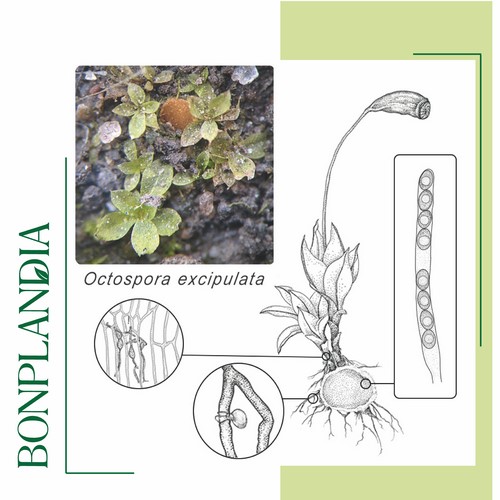Descubrimiento de Octospora excipulata (Pezizales) en Sudamérica
DOI:
https://doi.org/10.30972/bon.3417990Palabras clave:
Argentina, bryoparasitic Pezizales, Funaria, Funariaceae, Pyronemataceae, YungasResumen
El ascomiceto briófilo Octospora excipulata (Clem.) Benkert se reporta como un nuevo registro en América del Sur, basado en muestras recolectadas en Tucumán, Argentina. La especie fue observada infectando a Funaria calvescens (Funariaceae), un musgo americano. Este estudio proporciona una descripción concisa e ilustraciones que destacan tanto las características macroscópicas como microscópicas de la especie. Además, se incluyen comentarios sobre la identidad del huésped.
Descargas
Citas
Benkert, D. (2008) [2007]. Zur Kenntnis des Vorkommens bryophiler Pezizales (Ascomycota) in Südost-Europa. Mycologia Montenegrina 10: 7-21.
Delgadillo-Moya, C., Escolástico, D. A., Hernández-Rodríguez, E., Herrera-Paniagua, P., Peña-Retes, P. & Juárez-Martínez, C. (2022). Manual de Briofitas. 3ra ed. Universidad Nacional Autónoma de México, México.
Dias, M. S., Fernandes Peralta, D. & Da Silva Neto, S. J. (2018). Taxonomic treatment of the Funariaceae from Brazil. Phytotaxa 357: 77-93. https://doi.org/10.11646/phytotaxa.357.2.1
Eckstein, J. (2016). Key to main groups of bryoparasitic Pezizales. http://www.octospora.de/identification. htm (Accessed: 15/07/2024).
Eckstein, J. (2024). Bryoparasitic Pezizales. http:// www.octospora.de (Accessed: 15/07/2024)
Frahm, J. P., Pócs, T., O ́Shea, B. Koponen, T., Piippo, S., Enroth, J., Rao, P. & Fang, Y. M. (2003). Manual of Tropical Bryology. Board, Germany. https://doi.org/10.11646/bde.23.1.1
Gamundí, I. J. (1960). Discomycetes operculados de la Argentina familias Pezizaceae y Humariaceae. Lilloa 30: 296-338.
Gamundí, I. J. (1973). Discomycetes de Tierra del Fuego II. Especies nuevas de Humariaceae. Boletín de la Sociedad Argentina de Botánica 15: 85-92.
Gamundí, I. J., Minter, D. W., Romero, A. I., Barrera, V. A., Giaiotti, L. A., Messuti, M. I. & Stecconi, M. (2004). Checklist of the discomycetes (Fungi) of Patagonia, Tierra del Fuego and adjacent Antarctic areas. Darwiniana 42: 63-164. https://doi.org/10.14522/darwiniana.2014.421-4.155
Janošík, L., Sochorová, Z., Eckstein, J., Vega, M. & Koukol, O. (2022). Ascospore morphology of bryophilous Pezizales is closely associated with the place of infection and host ecology. Fungal Ecology 61: 101200. https://doi.org/10.1016/j. funeco.2022.101200
Jukić, N., Tomić, S., Sabovljević, M. & Omerović, N. (2018). Notes on some bryophilous Pezizales (fungi) in the Mediterranean part of Bosnia and Herzegovina. Glasnik Šumarskogfakulteta Univerziteta u Banjoj Luci 28: 71-83. https://doi.org/10.17110/StudBot.2017.48.1.105
Németh, C. (2017). Octospora erzbergeri (Pyronemataceae), a bryophilous ascomycete in Hungary. Studia Botanica Hungarica 48: 105-123. https://doi.org/10.17110/StudBot.2017.48.1.105
Németh, C., Vega, M., Hernanz, J., Eckstein, J. & Janošík L. (2023). Octospora entosthodontophila, a new smoothspored bryophilous ascomycete on Entosthodon spp. Herzogia 36: 283-304. https://doi.org/10.13158/ heia.36.2.2023.283
Ochi, H. (1968). A revision of the family Funariaceae (Musci) in Japan and the adjacent regions. Japanese Journal of Botany 20: 1-34.
Sharp, A. J., Crum, H. A. & Eckel, P. M. (eds). (1994). The Moss Flora of Mexico. Memoirs of the New York Botanical Garden 69: 1-1113.
Suárez, G. M., Dominguez, F. G., Pajot, H., Flores, J. R. & Catania, M. (2023). Octospora tucumanensis (Pezizales), a new bryophilous ascomycete on Dimerodontium balansae (Bryophyta) from Argentina. Mycological Progress 22:54: 1-19. https://doi.org/10.1007/s11557-023-01909-1

Descargas
Publicado
Versiones
- 2025-02-24 (3)
- 2024-12-20 (2)
- 2024-12-20 (1)
Cómo citar
Número
Sección
Licencia
Derechos de autor 2024 Bonplandia

Esta obra está bajo una licencia internacional Creative Commons Atribución 4.0.
Declaration of Adhesion to Open Access
- All contents of Bonplandia journal are available online, open to all and for free, before they are printed.
Copyright Notice
- Bonplandia magazine allows authors to retain their copyright without restrictions.
- The journal is under a Creative Commons Attribution 4.0 International license.














.jpg)


